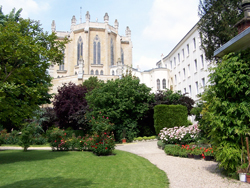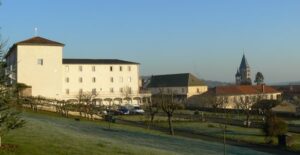History
Anne-Marie Javouhey, born on November 10, 1779 in the village of Chamblanc in Burgundy, heard God's call to proclaim His love for all people on all five continents, regardless of culture, religion or social status. Here are the key dates in her life.

Key dates
- 1779 : November 10, birth of Anne-Marie Javouhey in a village in Burgundy, France
- 1798 : November, 11, consecration to God during a clandestine mass
- 1807 : Foundation of the congregation in Chalon-sur-Saône
- 1812 : Acquisition of the house in Cluny; the congregation takes the name of Saint Joseph of Cluny
- 1817 : Sisters left for Bourbon Island (Reunion Island) and later for Senegal, the French and English West Indies, Saint Pierre and Miquelon, India, Oceania and Madagascar.
- 1822 : The founder leaves for two years in Africa: Senegal, Gambia, Sierra Leone
- 1828 : She went to Mana in French Guiana until 1833.
- 1835 : Mother Javouhey's second visit to French Guiana, where the government entrusted her with the task of preparing hundreds of slaves for their liberation
- 1840 : September 19 : ordination in Paris of the first three Senegalese priests trained by Mother Javouhey
- 1843 : In August, Mother Javouhey returned to France after all the slaves in Mana had been freed.
- 1849 : Acquisition of the house that was to become the Maison-Mère, in Faubourg Saint Jacques, Paris

- 1851 July 15 : Death of Anne-Marie Javouhey in Paris. She leaves behind more than 1,000 Sisters in 140 communities on five continents of the world.
- 1950 : Beatification of Anne-Marie Javouhey in Rome by Pope Pius XII.
- 2004 : Chamblanc, Seurre and Jallanges (Anne-Marie Javouhey's childhood towns) are made part of UNESCO's international "Route of the abolition of slavery" project as part of the "International Year to Commemorate the Struggle against Slavery and its Abolition",
- 2011 : The descendants of the 185 slaves freed by Anne-Marie Javouhey in 1838 are following in the footsteps of their "ché Mé" to plant the 'memory forest' in three places: Jallanges, the village where she was born, Seurre, where she was baptised, and Chamblanc, the village where she grew up.
Sources
Our congregation is fortunate to have several places that are considered the 'sources' of the congregation. These locations give us a glance at the history, heritage and actual living spaces of our founder.
There are a number of places in mainland France that are close to our hearts and that tell our story.

The 'sources' of the Sisters of Saint Joseph of Cluny in France :
- Jallanges :where Anne-Marie Javouhey was born and spent her early childhood.
- Seurre : where Nanette (Anne-Marie Javouhey) was baptised.
- Chamblanc :the family home where she spent her childhood and adolescence.
- Cluny :who gave it's name to the institute, and was the location of the first Mother House from 1812 to 1854.
- Autun :installation of the first "technical" school
- Paris :the second Mother House, bought in 1849 and the place of her death.
- Senlis : where she was buried.

